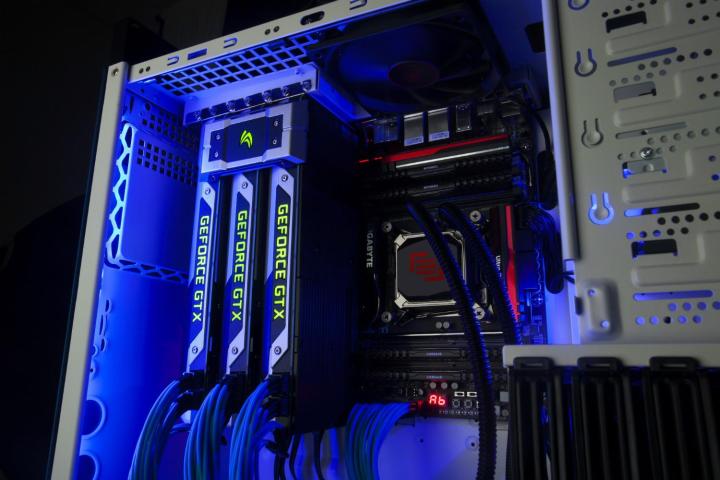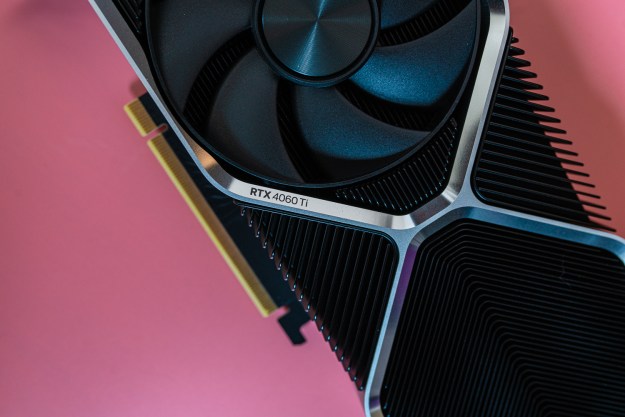
Now that Nvidia has launched its new Maxwell-based GeForce GTX 980 and 970 graphics cards, PC maker Maingear now offers both components as configurable options with a handful of its systems.
Maingear announced that you can get either the GTX 980 or the GTX 970 with its Shift, F131, Vybe, Rush, and Force gaming desktops. Each of these systems are tower-based PCs, and are configurable with a range of CPUs from Intel and/or AMD.
Related: Nvidia GeForce GTX 980 review, specs, benchmarked
Here’s a brief breakdown of each new graphics card.
GeForce GTX 980
The GeForce GTX 980 is powered by 2,048 CUDA cores, and sports a base clock of 1,126MHz, a boost clock of 1,216MHz, and a memory clock of 7,000MHz. The GTX 980 has 4GB of GDDR5 RAM, a memory bus of 256-bits, and memory bandwidth of 224GB/s. The 980 has a trio of DisplayPort connectors, an HDMI port, and a dual-link DVI port.
Related: Maingear Torq review
One of the most impressive aspects of the GTX 980 is the fact that you need significantly less power to run it compared to the 780Ti. The GeForce GTX 980 has a thermal design power (which is a measurement of power consumption) of 165-watts, while the 780Ti, which is the card that it’s replacing, has a TDP of 250 watts.
GeForce GTX 970
The GeForce GTX 970, which is a step below the 980, wields 1,664 CUDA cores, along with base and boost clocks of 1,050MHz, and 1,178MHz, respectively. Like the 980, the 970 also sports a 7,000MHz memory clock, and carries 4GB of GDDR5 RAM. That’s double what the Nvidia GeForce GTX 770 has (2GB). The 970 is replacing the 770.
The 970 features a 256-bit memory bus, and memory bandwidth of 224GB/s, just like the 770. Like the GTX 980, it has three DisplayPort connectors, along with single HDMI, and dual-link DVI ports.
The 970 is significantly more power efficient than the 770. The GeForce GTX 970 has a TDP of only 145 watts, which is nearly 100 watts lower (230) than what the GTX 770 demands.
Possible Maingear configurations with a GTX 980/970
We’ll now take you through a configuration of each Maingear desktop that offers both the 980 and the 970. This way, you can get a clearer idea of how much you should expect to shell out for a system outfitted with either card.
Using the Maingear Shift configuration page, we put together a system consisting of an Intel Core i5-4590 quad core CPU running at 3.3GHz, a GeForce GTX 980, 8GB of RAM, a 1TB hybrid hard drive, and a Gigabyte GA-Z97X-SLI motherboard for $2,249. Stepping down to a GTX 970 lowers the price to $1,975.
With the same specs, a Maingear Vybe with a GTX 980 will run you $1,726. That price drops to $1,452 if you swap out the 980 with a 970. A similarly spec-ed Maingear F131 with a 980 will run you $1,854, and falls to $1,580 if you opt for a GTX 970 instead.
Next up is the Maingear Rush. It’s worth noting that, unlike the other desktops we’ve touched on so far, The Z97-based version can’t be had with less than 16GB of RAM, or a CPU lower than an Intel Core i7-4790K running at 4GHz. With a GTX 980 in tow, the Rush will run you $3,248.50. Stepping down to the 970 shaves the price down to $2,974.50.
The Z97-based Maingear Force also can’t be had with less than a 4970K CPU, or 16GB of RAM. With that in mind, you can get a GTX 980 in the Force for $4,070.50. Downgrading to a GTX 970 cuts the price to $3,796.50.
If you just want to buy the Nvidia GeForce GTX 980 or 970 solo from a site like Newegg, they’re going for roughly $549, and $329, respectively.
Editors' Recommendations
- Nvidia just made GeForce Now so much better
- Nvidia is missing a golden opportunity in PC gaming
- I made an entire PC build for the price of one Nvidia GPU
- Nvidia is cheating with its GPUs, and that’s great for laptops
- This Starfield mod adds Nvidia’s DLSS 3 — for free



